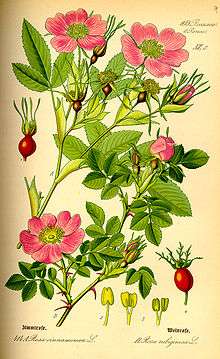Rosales
| Rosales | |
|---|---|
 | |
| Two rose plants, Rosa cinnamomea L. and R. rubiginosa L. | |
| Scientific classification | |
| Kingdom: | Plantae |
| Clade: | Angiosperms |
| Clade: | Eudicots |
| Clade: | Rosids |
| Clade: | Fabids |
| Order: | Rosales Bercht. & J.Presl[1] |
| Families | |
|
Barbeyaceae | |
| Synonyms | |
|
Rhamnales | |
Rosales is an order of flowering plants.[3] It is sister to a clade consisting of Fagales and Cucurbitales.[4] It contains about 7700 species, distributed into about 260 genera. Rosales comprise nine families, the type family being the rose family, Rosaceae. The largest of these families are Rosaceae (90/2500) and Urticaceae (54/2600). The order Rosales is divided into three clades that have never been assigned a taxonomic rank. The basal clade consists of the family Rosaceae; another clade consists of four families, including Rhamnaceae; and the third clade consists of the four urticalean families.[5]
The order Rosales is strongly supported as monophyletic in phylogenetic analyses of DNA sequences, such as those carried out by members of the Angiosperm Phylogeny Group.[6] In their APG III system of plant classification, they defined Rosales as consisting of the nine families listed in the box on the right.[1] The relationships of these families were uncertain until 2011, when they were resolved in a molecular phylogenetic study based on two nuclear genes and ten chloroplast genes.[7]
Well-known members of Rosales include: roses, strawberries, blackberries and raspberries, apples and pears, plums, peaches and apricots, almonds, rowan and hawthorn, jujube, elms, banyans, figs, mulberries, breadfruit, nettles, hops, and cannabis.
Taxonomy
In the classification system of Dahlgren the Rosales were in the superorder Rosiflorae (also called Rosanae). In the obsolete Cronquist system, the order Rosales was many times polyphyletic. It consisted of the family Rosaceae and 23 other families that are now placed in various other orders.[8] These families and their placement in the APG III system are:[1]
- Alseuosmiaceae (Asterales)
- Anisophylleaceae (Cucurbitales)
- Brunelliaceae (Oxalidales)
- Bruniaceae (Bruniales)
- Byblidaceae (Lamiales)
- Cephalotaceae (Oxalidales)
- Chrysobalanaceae (Malpighiales)
- Columelliaceae (Bruniales)
- Connaraceae (Oxalidales)
- Crassulaceae (Saxifragales)
- Crossosomataceae (Crossosomatales)
- Cunoniaceae (Oxalidales)
- Davidsoniaceae (Cunoniaceae, Oxalidales)
- Dialypetalanthaceae (Rubiaceae, Gentianales)
- Eucryphiaceae (Cunoniaceae, Oxalidales)
- Greyiaceae (Melianthaceae, Geraniales)
- Grossulariaceae (Saxifragales)
- Hydrangeaceae (Cornales)
- Neuradaceae (Malvales)
- Pittosporaceae (Apiales)
- Rhabdodendraceae (Caryophyllales)
- Rosaceae
- Saxifragaceae (Saxifragales)
- Surianaceae (Fabales)
Phylogeny
The following phylogenetic tree is from a cladistic analysis of DNA that was published in 2011.[7]
| Rosales |
| ||||||||||||||||||||||||||||||||||||||||||||||||
| |
References
- 1 2 3 Angiosperm Phylogeny Group (2009). "An update of the Angiosperm Phylogeny Group classification for the orders and families of flowering plants: APG III" (PDF). Botanical Journal of the Linnean Society. 161 (2): 105–121. doi:10.1111/j.1095-8339.2009.00996.x. Retrieved 2013-07-06.
- ↑ UniProt. "Order Rosales". Retrieved 2008-04-24.
- ↑ Peter F. Stevens (2001 onwards). "Rosales". At: Trees At: Angiosperm Phylogeny Website. At: Missouri Botanical Garden Website. (see External links below)
- ↑ Hengchang Wang; Michael J. Moore; Pamela S. Soltis; Charles D. Bell; Samuel F. Brockington; Roolse Alexandre; Charles C. Davis; Maribeth Latvis; Steven R. Manchester & Douglas E. Soltis (10 Mar 2009), "Rosid radiation and the rapid rise of angiosperm-dominated forests", Proceedings of the National Academy of Sciences, 106 (10): 3853–3858, doi:10.1073/pnas.0813376106, PMC 2644257
 , PMID 19223592
, PMID 19223592 - ↑ Douglas E. Soltis, et alii. (28 authors). 2011. "Angiosperm Phylogeny: 17 genes, 640 taxa". American Journal of Botany 98(4):704-730. doi:10.3732/ajb.1000404
- ↑ Walter S. Judd, Christopher S. Campbell, Elizabeth A. Kellogg, Peter F. Stevens, and Michael J. Donoghue. 2008. Plant Systematics: A Phylogenetic Approach, Third Edition. Sinauer Associates: Sunderland, MA, USA. ISBN 978-0-87893-407-2
- 1 2 Shu-dong Zhang, De-zhu Li; Soltis, Douglas E.; Yang, Yang; Ting-shuang, Yi (July 2011). "Multi-gene analysis provides a well-supported phylogeny of Rosales". Molecular Phylogenetics and Evolution. 60 (1): 21–28. doi:10.1016/j.ympev.2011.04.008. PMID 21540119.
- ↑ Arthur John Cronquist. 1981. An Integrated System of Classification of Flowering Plants. Columbia University Press: New York, NY, USA. ISBN 978-0-231-03880-5
External links
-
 Media related to Rosales at Wikimedia Commons
Media related to Rosales at Wikimedia Commons -
 Data related to Rosales at Wikispecies
Data related to Rosales at Wikispecies - Rosales At: Trees At: Angiosperm Phylogeny Website At: Missouri Botanical Garden Website
- Rosales – Plant Life Forms
- "Rosales". Integrated Taxonomic Information System. Retrieved 24 April 2008.